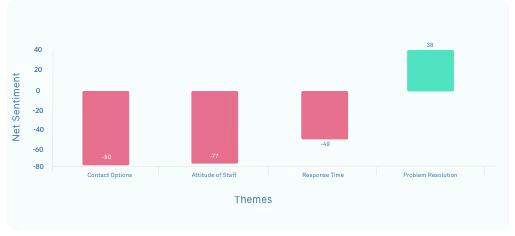The following article is Chapter 3 in the Ultimate Guide to Net Promoter Score. The Net Promoter Score (NPS), is the world's leading metric for measuring customer loyalty and happiness. In this article, we give some tips on performing Net Promoter Score analysis.
Net Promoter Score: Verbatim Analysis
If your goal is to build exceptional experiences for your customers, it's essential you get critical stakeholders on the product, marketing, business ops, customer service onboard right from the beginning. Without this, the NPS survey analysis may get overlooked during the product development lifecycle. It's also essential the information is easily accessible on dashboards across multiple teams to ensure company efforts are aligned on improving the rights areas.
Secondly, while your NPS score is useful for maintaining a constant finger on the pulse of how your customers feel about your business or service, analysing the open-ended questions included on your survey gives you the most actionable part of the NPS survey.
To get to the ‘why’ of your score the categorization of the open-ended verbatim comments from promoters and detractors into themes and tag comment sentiment is necessary.
Themes
A theme is simply feedback around a recurring topic; for example, shipping times, support tickets or prices. You may already have an idea of some themes just from reading through the feedback you’ve already received. Or, as you begin to tag your feedback, you’ll likely start to see themes naturally emerging. One potential difficulty with tracking themes is how many different ways there are to give feedback around one theme; for example, if your theme is “shipping times,” you may see feedback like “fast shipping,” “lightning quick” and “arrived on time.” There are so many different ways for people to refer to the same theme, which can make theme tagging labour intensive.

Sentiment
Another way to organise analytics is by the sentiment of the customer. Sentiment is more closely related to NPS because, broadly, it means assigning a metric to a piece of feedback that details how positive or negative that feedback is.

Approaches to text analytics
There are a number of ways to analyze your customers’ feedback, each with pros and cons.
Rule-based approaches
Rule-based analytics rely on sets of rules to determine which keywords found in customer feedback are positive and which are negative, and then determine a cumulative score for the feedback based on how many positive and negative words were found. Since rule-based analytics can function only within the boundaries of their existing rules, they work well when the scope of what they’re analyzing is narrow.
Excel Macro approaches
It’s possible to use Excel macros to collect rule-based analytics. Keywords can have values attached that denote how positive or negative they are, and then Excel will assign an average value to each piece of feedback depending on the number of positive and negative keywords found. This method is limited because keywords must be manually entered and assigned value.
AI approaches
Many customers provide a response to the NPS follow-up question, “Care to tell us why you’ve given us this score?” Promoters, for example, want organisations to continue to do well, but they often ask for specific changes. Acting upon unstructured data has been painful in the past and has involved teams crawling through feedback on a 1:1 basis. It's inconceivable for a large company to ask every customer for feedback and to read each one. If you try to do it yourself, you will struggle to notice an emerging theme and fail as soon as your volumes get into 100’s.
Fortunately, modern technology allows you to break the trade-off between quality and quantity of insight. AI-powered text analytics tools can analyse large-scale responses, surfaces key themes, and reveal what is truly significant to your business. With machine learning, you can understand every single comment and provide you with an aggregated view of what drives your feedback in real time.
In today’s world, an NPS score alone cannot provide the full picture of the customer experience. Natural language understanding is a critical component to customer feedback mechanisms like NPS. It enables organisations to utilise large amounts of feedback real-time to develop a complete understanding of customer’s needs.
Next Chapter
Net Promoter Score (NPS) Analysis: FAQs
What is Net Promoter Score (NPS) analysis?
NPS analysis is the process of examining customer survey responses to understand how likely customers are to recommend a brand, product, or service. It helps identify promoters, passives, and detractors and reveals the reasons behind their ratings.
Why is NPS analysis important?
It goes beyond the score itself to uncover drivers of loyalty and dissatisfaction. Effective analysis helps businesses reduce churn, strengthen relationships, and prioritize improvements that have the biggest impact.
How do you conduct an effective NPS analysis?
An effective analysis involves segmenting responses by customer groups, categorizing feedback, identifying recurring themes, and linking results to business outcomes such as retention or revenue growth.
What types of insights can NPS analysis provide?
NPS analysis highlights why customers are loyal, what pain points drive detractors, and where opportunities exist for improvement. It can also reveal differences across demographics, regions, or product lines.
What role does qualitative feedback play in NPS analysis?
Qualitative feedback explains the “why” behind customer ratings. Analyzing open-text responses provides context that raw numbers alone cannot capture.
How can businesses act on NPS analysis?
Businesses can use insights to improve customer support, enhance product features, personalize experiences, and close the loop by addressing detractor concerns directly.
What tools support NPS analysis?
Tools such as feedback analytics platforms, sentiment analysis software, and dashboards make it easier to categorize comments, detect patterns, and measure results over time.
How often should NPS analysis be performed?
NPS should be measured and analyzed regularly—quarterly or after key interactions—to track progress and respond quickly to shifts in customer sentiment.















